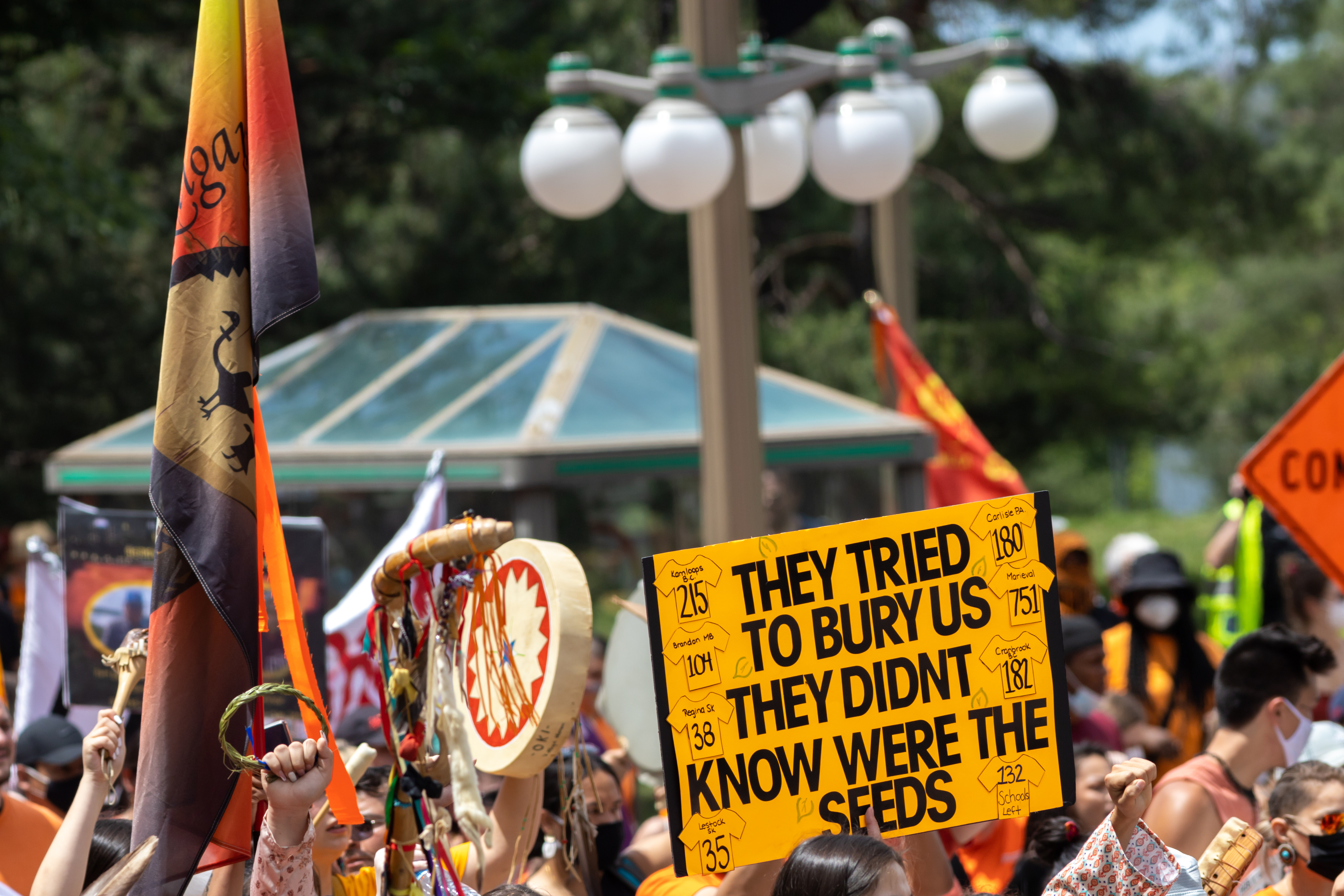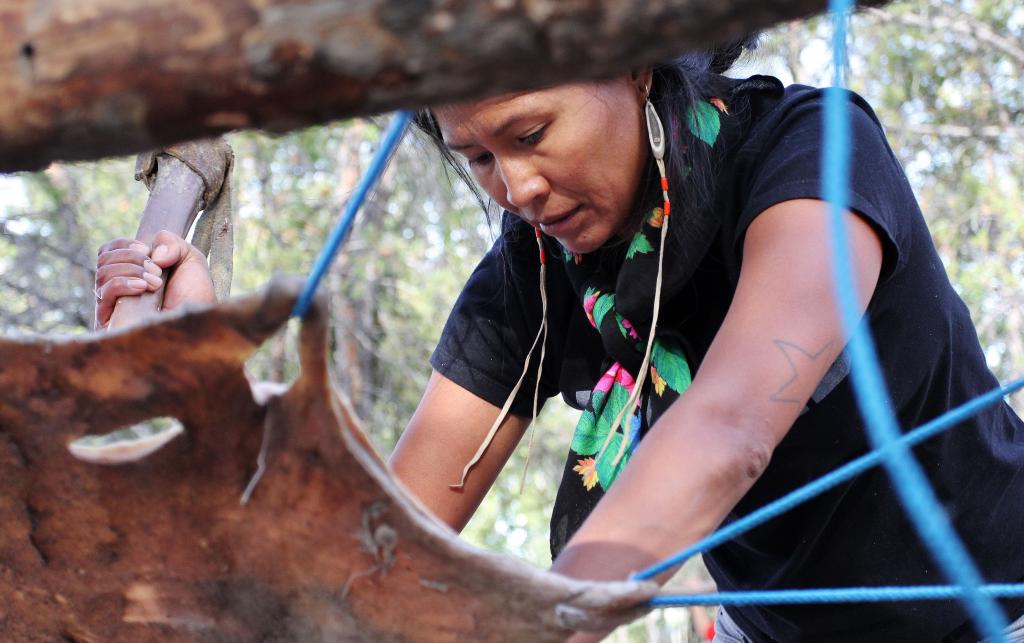— Land as kin, by Shawkay Ottmann

by Shawkay Ottmann
Shawkay Ottmann is a PhD student at Cornell University in the Apparel Design program. She has undertaken research and published writing at the intersections of fashion and Indigenous participation for a range of publications and contexts.
Canada is not known for its fashion. It has not traditionally held a position on the list of fashion capitals, and it is not currently a major clothing and textiles manufacturer.83
Yet, the foundations of the Canadian state were built on the fashion industry. When the Hudson’s Bay Company claimed what would become Canadian territory, it was in the name of fur. The push into First Nations land, the relationships formed with First Nations and Inuit peoples was primarily for the fur trade. While the ravages of the clothing and textile industry can be seen globally, perhaps it is in a nation built on fashion that an antidote to the crisis can also be found. Not in the history of the first corporation nor in the area and the consequent settler-colonial state, but in the Indigenous practices that have continued from the pre-colonial era into the present day.
Diverse cultures can be found across the continent, with many First Nations, Inuit, and Métis peoples living with different ways of being, knowing and doing. In Canada alone, there are more than 50 distinct nations and 50 Indigenous languages.84
With the existence of extensive pre-colonial trade routes, however, knowledge, beliefs, and cultural practices were widely disseminated, which allowed for similar cultural expressions throughout many nations.85
The intimate understanding of the land is included in the similarity in cultural expressions.
For Indigenous peoples across North America, all of nature is animate. Everything embodies spirit – animals, rocks and places – with creative processes and energies.86
As Potawatomi Nation botanist Robin Wall Kimmerer stated, in Indigenous ways of knowing “human people are often referred to as “the younger brothers of Creation. We say that humans have the least experience with how to live and thus the most to learn.”87
This quote reveals the lack of human exceptionalism in Indigenous ways of being and the understanding of land as kin.
Indigenous peoples are taught to be mindful of and make decisions considering ‘all my relations’, that is the extended relationships we share with all people, and further, with all of nature, with all creation. Land was and continues to be a living library, the means to not only survive, but to thrive in connection to the ancestors, our human and non-human kin. Land provides a home, and a means to understand identity. Thus, as kin, land is sacred and belongs to itself, therefore could not be bought or sold, but could only be shared.
As with all relationships, reciprocity is paramount. Nature sustains humanity, and in return humanity is to act as a steward to the land; to respect and follow the natural laws that create endless renewal and sustain all life. In the time before settler contact, all Indigenous clothing was land-based. That is, all clothing was created with elements from the land within the context of a reciprocal relationship, non-separation from, and interconnectedness with nature.88
Land-based practices are also deeply rooted in place, meaning that subsistence was found locally, with trade providing rarer resources.89
A sign of respect, and means to maintain reciprocity with the land that provided all materials, was in the creation of well-made clothing. Through respectful adornment, balance was maintained and relations with the natural world were deepened, meaning clothing was a fundamental marker of Indigenous ways of being.90
As fashion theory states that culture is embedded in the clothing people create and wear, and Indigenous culture is fundamentally linked to relationship with the land, then land is located on the body through dress.91
Private property
The ability to maintain a relationship with the land was, however, largely ripped away from Indigenous peoples. This happened slowly at first. When fur traders found their way to what would become Canada, initially First Nations peoples were able to continue pre-existing trade patterns. This changed as settlers increasingly pushed Indigenous peoples to the margins, often assuming they had title to the land. To legalize settler claims in the eyes of European states, in 1763, King George III issued a Royal Proclamation without negotiations with Indigenous nations, where he claimed extensive Indigenous lands and patronizingly placed Indigenous peoples under the Crown’s ‘protection’.92

With this proclamation, the meaning of land in North America changed. While Indigenous peoples continued to live out relationships with the land, settlers enforced the idea of land as property. The individualistic ideologies embedded within colonialism reduced land to a commodity.
Strict hierarchies and linear development required a singular, well-defined end goal of obtaining a ‘good life’ as modelled and defined by the heteropatriarchal capitalist Western European powers.93
Thus, land could be reduced to resources, to private property and an object that could be owned and whose resources could be extracted from, with no thought of sustainability.
Western ideologies have created the mass- producing, global capitalistic system that has led to an increasingly polluting fashion system that ignores human rights for unsustainable and continuous growth in profits.94
In a world where Indigenous relationships with the land were considered ‘savage’ and capitalism was ‘civilized’, Indigenous ways of being had to be erased and land-based fashion needed to become unobtainable to sustain the idea of a singularly-correct modern world. Not only did Indigenous land-based fashion become largely unobtainable, but the government aimed to erase Indigenous peoples altogether.
During the fur trading era, Indigenous peoples were found useful in building profit and expanding networks and influence.95
Later, in the American Revolutionary War and the War of 1812, First Nations were sought after as military allies. As war ceased to be a prominent issue and as the fur trade collapsed in 1821, First Nations were moved from useful economic and military partners to “social and economic problems who would benefit from Christianization and the adoption of sedentary agriculture.”96
In 1830, the Indian Affairs department (the branch of the British colonial government formed to deal with First Nations) was transferred from military officers to civilian administrators in response to this shift.97
The British colonial government started a paternal programme to incorporate Indigenous peoples into ‘white’ society through directed cultural change, or change based on coercion. Unlike undirected cultural change, directed change required a shift of worldview and could be successful in a society with more settlers than Indigenous people.
A directed cultural change required a deliberate and systematic attempt to change the culture of the marginalized group by undermining systems of belief, social and political structures, and psychic well-being. As historian J.R. Miller states, “It was not the fur trader or even the soldier who worked the worst damage on Canada’s Indians; it was the missionary, the schoolteacher, and the bureaucrat who thought they knew better than the indigenous peoples what was good for them.”98
In the 1830s, the deepest damage was only beginning. The main methods used to force cultural change was in the creation of residential schools and reserves.
The Canadian Indian residential school system was preceded by church-run schools as early as the 1630s and 40s. Theoretically, the schools were meant to ‘civilize’ and ‘Christianize’ Indigenous children while teaching basic skills.99
These schools, both prior to and after the 1880s creation of the government-run boarding school system, failed. The schools were plagued with mental, physical, and sexual abuse, malnourishment, disease, and death. Indeed, as an introduction to the schools, many survivors recall being stripped of their clothes upon arrival, the last physical connection to kin and culture destroyed and replaced by uniforms that were often little more than scraps.100
Throughout their time in these institutions, an estimated 50% of the children who attended the schools died.101
Yet, all failures were placed on the children and their parents, and so children were removed from their homes, their land, through force or coercion until the last school closed in 1996.102
With missionaries came the schools, but with the onslaught of settlers came land disputes. The Canadian government started negotiating treaties to gain access to and have First Nations surrender their claim to land. First Nations peoples entered into treaties as pacts of friendship and mutual assistance, along with an understanding that settlers would enter their land at some point in the future, and that they would be provided with the means to gradually move to an agricultural economy.103
Treaties were made from sovereign nation to sovereign nation.
Yet, with Canadian Confederation in 1867, Canada acted in bad faith. At the same time the 11 numbered treaties were being negotiated and signed from 1871-1921, legislation was being passed to move First Nations from under the protection of the king to being wards of the state.104
The Indian Affairs department was given extensive control, and in the Indian Acts of 1876 and 1880, along with the Indian Advancement Act of 1884, the government took the power to “mould, unilaterally, every aspect of life on the reserve and to create whatever infrastructure it deemed necessary to achieve the desired end”, the end of Indigenous people as an entity.105
In time, this would also include Metis and Inuit people along with status and non-status First Nations.106
Reserves became places where Indigenous peoples were no longer sovereign, where traditional political, spiritual, and economic practices were made illegal and European systems imposed.
Freedom of movement was disallowed, and Indigenous peoples could not sell their own goods, but had to go through an imposed system of colonial Indian agents. This system of reserves and residential schools purposefully created an inability to continue creating land-based fashion.
Land as fashion
The contemporary fashion industry is a continuation of the one that created Canada. It is part of a capitalist system that colonized in the name of labour and profit, that actively removed people from the land, severing their relationship with environments and reducing nature to an inanimate commodity that can be exploited. It is a system that attempted and attempts to destroy alternative ways of being while enforcing addictions to consumerism that ignores the true cost of ever-cheaper clothing.

Despite colonial attempts to destroy alternatives, there are increasing ways for Indigenous peoples to reclaim fashion that recognizes land as kin. Organizations like Dene Nahjo,107
creators like Kanina Terry108
, Amber Sandy,109
and Justine Woods110
, and classes like Indigenous Craft Practices at Toronto Metropolitan University111
all teach land-based fashion practices. Community networks are being rebuilt and jewellery designers like Tania Larsson112
and Naomi Bourque113
source land-based materials for pieces imbued with specific cultural meaning. Designers such as Robyn McLeod114
are creating innovative garments that are shown at events like Indigenous Fashion Arts in Toronto and the White Show at Milan Fashion Week. With this reclamation comes inherently sustainable, meaningful, empowering clothing that is the antithesis to the contemporary industry.
In the work of these communities, a way forward can be found. It can be found in supporting Indigenous and local land-based creators and in learning location-specific and diverse ancestral ways of creating from the land. Though perhaps the easiest way to start is in creating a relationship with our clothes again. Perhaps by extending our understanding of ‘all my relations’ to the clothes we already own, the care and commitment required to maintain our garments can also lessen the burden of production placed on the land. Perhaps the easiest way to start is appreciating the abundance we already have.
